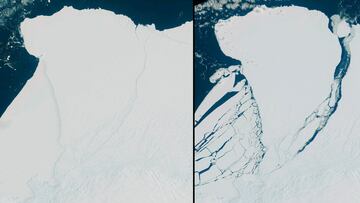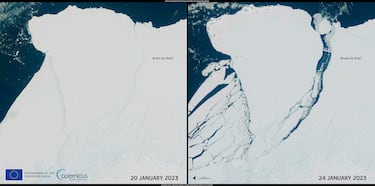Huge iceberg breaks off in the Antarctic: What is an iceberg and how do they affect the environment?
An iceberg the size of Greater London has broken off as the South Pole experiences significant ice retreat.

Earlier this week a huge block of ice, roughly the size of Greater London, became dislodged from an ice formation in the Antarctic and formed a giant iceberg in the ocean. The iceberg is thought to be about 600 square miles.
At first glance it may appear a consequence of climate change, but researchers from the British Antarctic Survey (BAS) have confirmed that this event was a result of expected ice movements at the South Pole. Cracks in the Brunt Ice Shelf were first identified around a decade ago and the full break was recorded in recent days.
The southern hemisphere is at the peak of summer and the higher-than-usual temperatures contributed to the situation. As a result, experts have found that ice has retreated further this year than in any year on record.

“This calving event has been expected and is part of the natural behavior of the Brunt Ice Shelf. It is not linked to climate change. Our science and operational teams continue to monitor the ice shelf in real-time to ensure it is safe, and to maintain the delivery of the science we undertake at Halley,” said BAS glaciologist Professor Dominic Hodgson.
“While the decline in Antarctic sea ice extent is always steep at this time of year, it has been unusually rapid this year,” the National Snow and Ice Data Center reported earlier this month. “And at the end of December, Antarctic sea ice extent stood at the lowest in the 45-year satellite record.”
What are icebergs?
Mostly originating from Greenland and Antarctica, icebergs are wandering masses which float around the earth’s two poles. Icebergs and the two polar caps account for approximately 70% of all fresh water on the planet.
Experts in the field estimate that icebergs are formed in temperatures of up to -89C (-128F), far below the frozen water in places where sunlight rarely reaches. Once huge blocks of ice have formed, icebergs occasionally detach as a result of marine currents, temperature changes and other environmental factors.
Related stories
Once dislodged from their polar perch, icebergs tend to drift into warmer waters and eventually melt. The lifespan of an iceberg - from forming on a glacier to melting into the ocean - can be up to 3,000 years. However this process may start to speed up if climate change continues to bring more extremes in temperature across the planet.
Given the vast resources of water frozen at both poles, a quickening of the melting process would bring up sea levels rapidly. This could have a disastrous impact on low-lying areas around the world and provides a severe threat to whole communities.


